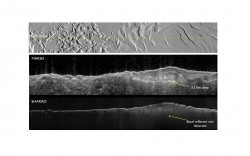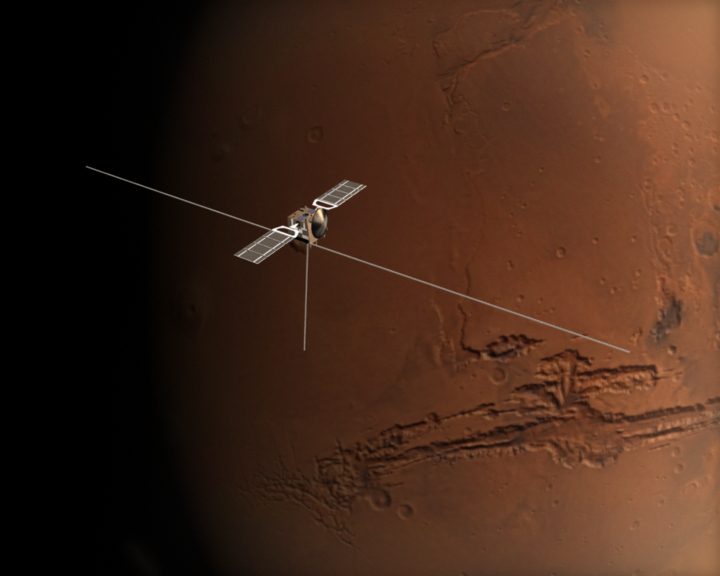To truly know and understand another world, planetary scientists need to look beneath the surface of that planet. This has been done on a small scale by looking inside impact craters, a la Opportunity and Spirit on Mars. But that only provides information for one area on a big planet. To get the global picture of the subsurface, a radar sounder instrument was developed for ESA’s Mars Express spacecraft. The Mars Advanced Radar for Subsurface and Ionosphere Sounding (MARSIS) experiment has now been successfully used for the first time to look beneath Mars’ south polar ice cap, opening up the third dimension for planetary exploration. “We have demonstrated that the polar caps at Mars are mostly water ice, and produced an inventory so now we know exactly how much water there is,†says Roberto Orosei, MARSIS Deputy Principal Investigator.
The data from MARSIS’ probe of the ice cap is still being analyzed, but scientists say they expect some surprising results to be revealed.
MARSIS is built to map the distribution of liquid and solid water in the upper portions of the Martian crust, and can investigate Mars’ subsurface up to a depth of 5 km. If reservoirs of water are detected, it will help us understand the hydrological, geological, climatic and possibly biological evolution of Mars. “At the south pole of Mars, we are seeing through ice 3.7 km thick. A small calculation shows that we could see through ice down to 20 km or more thick at Mars,†says Ali Safaeinili, MARSIS co-investigator.
No one had ever used a radar sounder from orbit on another planet before. So the team was uncertain it would work as planned. The subsurface of the planet might have been too opaque to the radar waves or the upper levels of Mars’ atmosphere (ionosphere) might have distorted the signal too much to be useful.
But, the instrument worked perfectly.

Every time a radar wave crosses a boundary between different substances, it generates an echo that the orbiter detects.
See ESA’s 3-D simulation of the radar instrument.
While MARSIS is still collecting data, a follow-up instrument is already operating at Mars. The Shallow Subsurface Radar (SHARAD) on NASA’s Mars Reconnaissance Orbiter works at higher frequencies than MARSIS and can see more details in the signals it receives from the underground layers, but it can’t penetrate the surface quite as far.
The technique’s success is prompting scientists to think of all the other places in the Solar System where they would like to use radar sounders. One obvious target is Jupiter’s icy moon, Europa. There, a radar sounder could probe the moon’s icy crust to help understand the puzzling features we see on the surface. It may even see the interface at the bottom of the ice where an ocean is expected to begin.
Asteroids and comets could be thoroughly scanned by a radar sounder, producing three-dimensional maps of their interior– perhaps exactly the data we will need if, one day, we have to nudge one out of Earth’s way. Also, this type of radar instrument could be used on our own planet to look inside Earth’s polar caps and ice sheets to determine their stability.
Mars Express has been orbiting the Red Planet since December 2003. It carries seven scientific experiments, including MARSIS, which was built by the Italian Space Agency with cooperation from JPL and the University of Iowa.
Original News Source: ESA press release


Hey PHWilson! If we find a subsurface ocean on Mars, we could name it “The Sea of Liberal Guilt”.
Nice,
I am looking forward for the results.
Who would have thought, we’d use up the water on another planet before our own,
I’m just anxious to hear results of further tests on the ice and it’s complete chemical/mineral contents. I’m certain that NASA has plans that lead to that, and then there will be a much greater picture of the history and activity of that planet. Also, the mapping of the subsurface ice (and maybe water?) will really give a clearer picture of what Mars is today. I cheer NASA and all others associated with these explorations of that fascinating place! I’m ready for Mars – “The Big Picture”!!! 🙂 😉